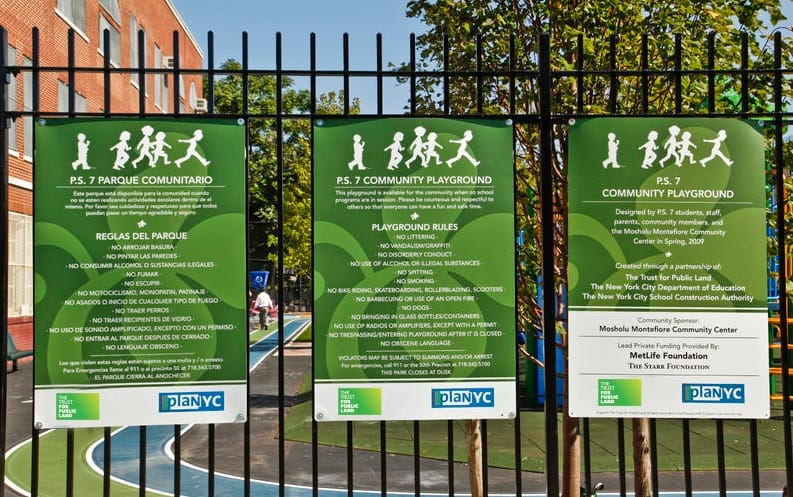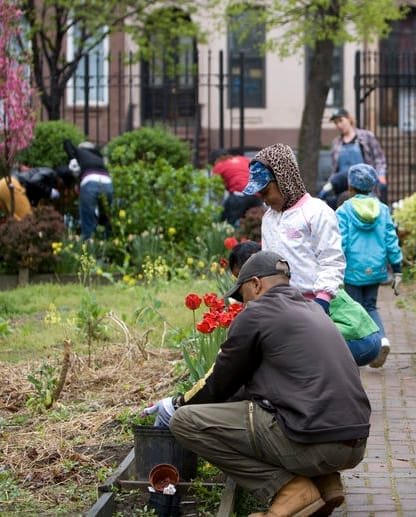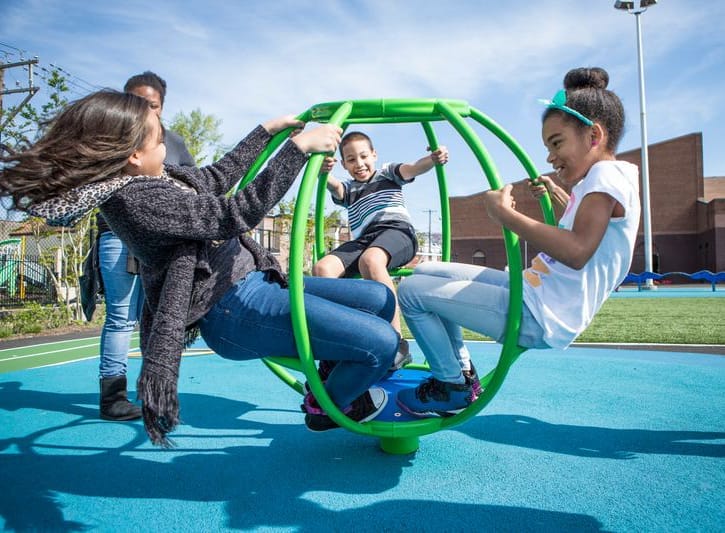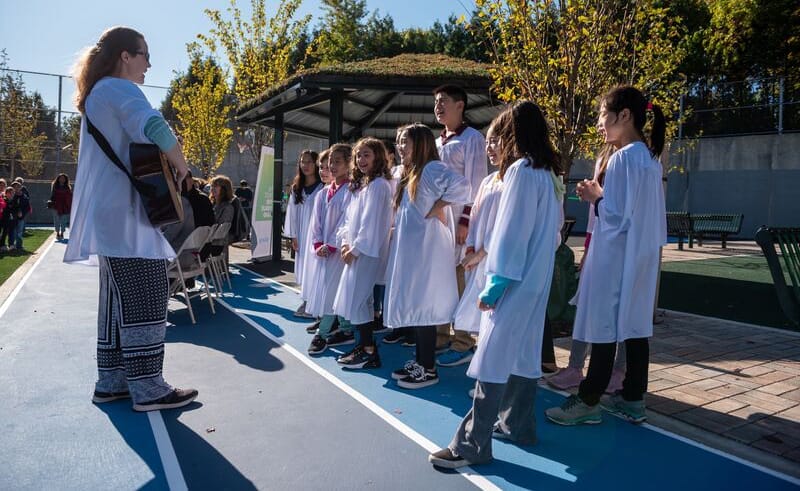
STEP 21: Celebrate
Congratulations! You did it! Celebrate this milestone by scheduling an opening celebration to thank all the people involved and have fun watching the kids play! This can be an excellent opportunity to thank stakeholders in the community and showcase what the student designers learned in the process. We often have the school plan a short performance given by a dance team, choir, or band to bring a sense of place and extra joy to the event. This is an important milestone, but the work has really just begun.
STEP 22: Outdoor Learning
Your schoolyard is ready for use. Work with your principal and teachers to get students outside to learn. We recommend planning a couple of training sessions with teachers during their professional development time to familiarize them with the practice of outdoor learning. The Trust for Public Land has a suite of learning resources to help connect students to outdoor learning, including garden-based lessons, math activities that use the entire playground space, green infrastructure education, and general tips and guidance for bringing any subject to an outdoor classroom. The playground offers ample opportunities for hands-on, project-based learning and offers students with different learning styles a new way to engage with curricular content. Research the informal education resources from the museums, gardens, and environmental nonprofits in your city for inspiration and partnership opportunities. Of course, recess and PE will also be enhanced and enriched by the new amenities.
STEP 23: Activating Your Schoolyard
Your new schoolyard is a tremendous asset not only for the students, but also for the whole community. However, people who are not already part of the school community may feel uneasy about using the schoolyard, and might need to be invited into the space. Creating an entry sign for your new schoolyard is an absolutely crucial part of the process. It may be tempting to skip this step. Don’t! Nationally, The Trust for Public Land has found that an entry sign is one of the most important determinants of how well used a park is. This is even more important for a schoolyard. Since schools are generally off-limits to people who are not students or staff, other community members need to be invited into the space. Are community members allowed in the space? During school hours or only after the school day ends? What types of activities are allowed? By providing an entry sign with the space’s hours and rules, you can clear up this confusion. The sign is also an opportunity to recognize community members, parents, staff, and funders who made the project a reality.
It is also important to plan for the different uses of the schoolyard. Hopefully, the space will come to be used for everything from in-school environmental educational programming, to after school arts classes, to evening adult sports leagues. These diverse uses don’t have to cause scheduling conflicts, since they all happen at different times. Using The Trust for Public Lands’ Playground Visioning Tool can help ensure that your schoolyard is well-utilized without being overscheduled. After the schoolyard opens, invite teachers, students, neighbors, after-school program providers, and parents to work through the tool, discussing top priority uses for the site and the best time for each.

It may sound silly, but a sign is one of the most important parts of your community schoolyard. A sign can welcome community members into the space, lay out the basic rules and hours of use, and educate visitors about the schoolyard environment. If your community schoolyard is open to the public during non-school hours, this needs to be explicitly stated; otherwise, people will be nervous about using the space.
© NANA TAIMOURWHITE

A Friends of the Schoolyard group is a great way to bring in the community, planning events, fostering a sense of shared stewardship, and troubleshooting when issues arise.
© SETH SHERMAN
STEP 23b: Creating a Friends of the Schoolyard Group
Whether your schoolyard has a history of community use after school or has been closed to the public until now, The Trust for Public Land has found that one of the best ways to encourage your neighbors to take care of your renovated yard is to form a friends of the schoolyard group. The focus of the group is to oversee use and upkeep of the yard and troubleshoot when issues arise. Much like a friends of the park group, the friends of the schoolyard group can plan seasonal events that bring in the community, create a culture of positive activity, and help foster a sense of shared stewardship.
Who should be in your friends of the schoolyard group? Perhaps during the design process, you identified neighbors or civic improvement groups that have ideas for schoolyard use. From the school, the students, teachers, after-school staff, and parents who participated in the design process are natural “seeds” for this group. It is also essential to invite members of the community to participate. You may have met someone from a neighborhood beautification group who offered to help care for the new garden beds or a resident across the street who is worried about unwanted activity in the yard and wants to help plan formal programming. Ask them to join the group and become involved in the schoolyard’s success. The friends of the schoolyard group is a great way to leverage opportunities to positively link the community to the schoolyard. A broadly representative schoolyard group creates goodwill between school and neighbors, puts more “eyes on the park,” and gives it a better chance of being well used and well-tended over the long term.
It can also be helpful to create a schoolyard leadership committee within the friends group. The committee is different from the larger, extended network of stewards; it is a small, committed group of people who will be lead stewards for your new playground. It will take initiative and motivate others to get involved.
It is important that the friends of the schoolyard group meet regularly to discuss the progress of the schoolyard, brainstorm ideas for events and programs, and facilitate the implementation of those ideas. If there are issues regarding use or maintenance, the group meetings function as a forum to hear those concerns and brainstorm possible solutions. You may decide to incorporate the schoolyard discussions into an existing framework, such as adding these discussions as a regular agenda item for your school leadership team meetings, where key school leaders are already gathered. Whichever you choose, it is important to find the time to talk about and organize around your schoolyard.
Meet Regularly
It is important that the schoolyard committee meet regularly to discuss the progress of the schoolyard, brainstorm ideas for events and programs, and facilitate the implementation of those ideas. If there are issues regarding use or maintenance, the schoolyard committee meetings function as a forum to hear those concerns and brainstorm possible solutions. You may decide to incorporate the schoolyard discussions into an existing framework, such as adding these discussions as a regular agenda item for your school leadership team meetings, where these key school leaders are already gathered. Whichever you choose, it is important to find the time to talk about and organize around your schoolyard.
STEP 24: Ensure Regular Maintenance
Ideally, the roles and responsibilities for maintaining the schoolyard should be clearly outlined in a memorandum of understanding (MOU) before beginning a partnership with a school community so that everyone is clear on what will be required to keep the playground thriving. When you partner with a school district, there’s no relationship more important to cultivate than that with the custodial engineer, who has eyes on the playground every day! The custodial engineer has already given input on the playground design, especially regarding maintenance needs like snowplow access and garbage removal. But when the school playground opens, it’s a good practice to hold a detailed walk-through, handing over play-equipment warranties, highlighting tree-care needs, and describing how to protect the color-seal art and winterize the drinking fountain. It’s important that the custodial engineer knows whom to reach out to when problems arise. The same system should apply to any individual or group taking on playground maintenance. Communication is essential for the speedy handling of issues.
It may also be possible to create a maintenance partnership with your local parks department, particularly where the schoolyard will be open to the public, since the schoolyard is playing the role of a park. In some cases, formal joint maintenance agreements are reached between the school district and the parks department, establishing how the schoolyard will be used by the public, which maintenance responsibilities the parks department will take on, and which will be carried out by the school. To make sure gardens are healthy and maintained, develop a calendar-based maintenance schedule. Spring and fall workdays are great ways for parents and kids to get out and enjoy the weather. If vegetable garden beds are part of the plan, identify tasks on the calendar to prepare the beds to be ready for seeds and starter plants when warm weather arrives. Check with the cooperative extension agent from your state land grant institution for assistance.
Final Thoughts
Congratulations on starting a community schoolyard project. Community Schoolyards can improve your school’s learning environment, increase access to outdoor recreation in your community, and create a healthier environment. You are on your way to an incredible achievement. The road ahead is tough, but we know you can do it! Below, we share a few final thoughts.
Keep Going!
The Trust for Public Land has been transforming schoolyards for over 25 years. We have worked with more than a dozen school districts around the country and have successfully created over 300 Community Schoolyards to date. We have assembled the best guidance from these experts to help you navigate through the process of transforming an existing underutilized schoolyard into a vibrant community schoolyard.
Does that mean that you cannot create your own community schoolyard? Of course not. Across the country, passionate community members are making a major impact by improving their local schoolyards and parks. We created this guide with them (and you!) in mind. It will take hard work, collaboration, and perseverance, but if you follow the steps outlined in this guide, you can make your community schoolyard a reality. Don’t get discouraged by setbacks—they happen to professionals too.
Team Work
Many hands make for light work. When community members and stakeholders partner to build a community schoolyard, they can transform a space. Remember that building relationships is a crucial part of this process, and inclusivity will make for a stronger project. When you hit a roadblock, work with your team to figure out how to address it. Remember, your community schoolyard team will grow and evolve as your project progresses. If you hit a problem that your team can’t solve, it might be an opportunity to add new members to your team.
Remember Why You Are Doing This!
Creating close-to-home opportunities to be in nature, play, and socialize will improve the health of your community and make it more resilient to climate change. Your hard work and dedication to this project will create a treasured outdoor destination for your school and community for generations to come. Community Schoolyards can maximize health and wellness, provide benefits to the community and the environment, and improve learning and quality of life for students. These spaces have the potential to jumpstart a positive relationship with nature and make an impact on the health, learning, and social and emotional lives of young people.
Have Questions about Community Schoolyards?
Feel free to reach out! Contact Danielle Denk, The Trust for Public Land’s National Community SchoolyardsTM Initiative Director, danielle.denk@tpl.org, with questions.

Most community schoolyard teams hit at least a few setbacks along the way. Don’t get discouraged!
Remember why you started this project in the first place. Your hard work and dedication will create a treasured
outdoor destination for your school and community for generations to come.
© JENNA STAMM

